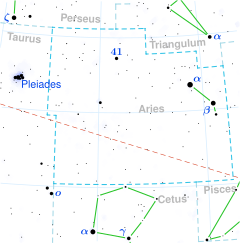41 아리에티스
41 Arietis| 관측 데이터 에폭 J2000 이쿼녹스 J2000 | |
|---|---|
| 별자리 | 양자리 |
| 우측 상승 | 02h 49m 59.03324s[1] |
| 탈위임 | +27° 15′ 37.8260″[1] |
| 겉보기 크기 (V) | 3.63[2] |
| 특성. | |
| 스펙트럼형 | B8 Vn[3] |
| U-B색지수 | –0.38[2] |
| B-V색지수 | –0.10[2] |
| 아스트로메트리 | |
| 방사 속도 (Rv) | +4km[4]/s |
| 고유 운동 (μ) | RA: +66.81[1]mas/yr Dec.: –1975.52mas[1]/yr |
| 시차 (π) | 19.69 ± 0.19[1] 마스 |
| 거리 | 166 ± 2 리 (50.8 ± 0.5 pc) |
| 세부 사항 | |
| 미사 | 3.1±0.1[5] M☉ |
| 루미도 | 160[6] L☉ |
| 온도 | 11900[6] K |
| 회전 속도 (v sin i) | 초속 175km[7] |
| 나이 | 130+10 −30[5] 마이어 |
| 기타 지정 | |
| 데이터베이스 참조 | |
| 심바드 | 자료 |
41 아리에티스(약칭 41 Ari)는 양자리 북쪽 별자리에 있는 3성계다. 외관상 3.63의 시각적 크기를 가진 이 시스템은 육안으로 쉽게 볼 수 있다.[2] 연간 시차 교대조 19.69 mas로 태양으로부터 166광년(51파섹) 거리에 있음을 나타낸다.[1]
이 시스템은 아리에티스 A로 지정된 바이너리 쌍으로 구성되며,[9] 세 번째 동반성인 41 아리에티스 D. (41 아리에티스 B와 C는 A와 광학 쌍을 이루지만 물리적으로는 관련이 없다.)[10] A의 성분은 그 자체로 41 Arietis Aa(공식 명칭: Bharani /bbrrnini/)[11]와 Ab로 지정되어 있다.
명명법
41 아리에티스는 이 시스템의 플램스티드 명칭이다. 그리스 문자 바이엘 명칭을 가지고 있지 않은데, 이 시스템은 한때는 현재 자리하고 있는 무스카 보렐리스 별자리의 일부였기 때문이다. 그러나 때때로 c 아리에티스로 지정되기도 한다. 두 성분의 Arietis A와 D 41, 그리고 A의 성분의 Arietis Aa와 Ab 41은 워싱턴 다중성 카탈로그(WMC)에서 사용하고 국제천문연맹(IAU)에서 채택한 규약에서 유래한다.[12]
니콜라스 루이 드 라카유는 1757년 이 별을 '릴륨의 남쪽'(/ latinɔstrastrann/// calledˈ latin/ /ˈ latin latin latin/ calledˈ latin latin latin)이라고 불렀는데,[13][14] 지금은 사라진 릴리움 별자리의 별자리로서 '릴륨의 남쪽' (라틴어로)이라고 불렀다. 그에게 39 아리에티스는 '릴륨의 북쪽'인 Līliī Borea였다.
힌두 천문학에서 바라니(Barani, Bharani, Sanskrit 발음: [bbɽiiiiɐiiiiiii]]])는 아리에티스 35, 39, 41에 해당하는 제2의 나크샤트라 또는 달 저택이다. 2016년 IAU는 스타들의 적절한 이름을 분류하고 표준화하기 위해 스타 네임 작업 그룹(WGSN)[15]을 조직했다. WGSN은 전체 다중 시스템보다는 개별 별에 적절한 이름을 부여하기로 결정했다.[16] 그것은 2017년 6월 30일 41 아리에티스 AA의 바라니라는 이름을 승인했고, 현재는 IAU가 승인한 스타 네임 리스트에 포함되었다.[11]
중국어로 위(배성)를 뜻하는 胃宿(웨수)는 아리에티스 41, 35, 39로 구성된 별칭을 말한다.[17] 따라서 41 아리에티스의 중국식 이름 자체가 胃宿(Wei Susan, 영어: 제3의 별)이다.[18]
아베스탄에서는 이 별을 우파파아이로 알려졌으며, 야자타 중 하나와 연관되어 있었다.[19]
특성.
1차 성분은 B8Vn의 별 분류를 가진 B형 주계열성이다.[3] 접미사 'n'은 빠른 회전의 도플러 효과로 인한 항성 스펙트럼 내 '신비한' 흡수선을 나타낸다. 그것은 175 km/s의 예상 회전 속도를 가지고 있다.[7] 이것은 별의 극 반지름보다 12% 더 큰 적도 불집을 만들고 있다.[20] AB도라두스 이동 그룹의[6] 후보 멤버로 0.3아크초의 각진격차로 궤도를 선회하는 동반자가 있다.[9]
참조
- ^ a b c d e f van Leeuwen, F. (November 2007), "Validation of the new Hipparcos reduction", Astronomy and Astrophysics, 474 (2): 653–664, arXiv:0708.1752, Bibcode:2007A&A...474..653V, doi:10.1051/0004-6361:20078357, S2CID 18759600.
- ^ a b c d Johnson, H. L.; et al. (1966), "UBVRIJKL photometry of the bright stars", Communications of the Lunar and Planetary Laboratory, 4 (99): 99, Bibcode:1966CoLPL...4...99J.
- ^ a b Cowley, A. (November 1972), "Spectral classification of the bright B8 stars", Astronomical Journal, 77: 750–755, Bibcode:1972AJ.....77..750C, doi:10.1086/111348.
- ^ Wilson, Ralph Elmer (1953), "General Catalogue of Stellar Radial Velocities", Carnegie Institute Washington D.C. Publication, Washington: Carnegie Institution of Washington, Bibcode:1953GCRV..C......0W.
- ^ a b Janson, Markus; et al. (August 2011), "High-contrast Imaging Search for Planets and Brown Dwarfs around the Most Massive Stars in the Solar Neighborhood", The Astrophysical Journal, 736 (2): 89, arXiv:1105.2577, Bibcode:2011ApJ...736...89J, doi:10.1088/0004-637X/736/2/89, S2CID 119217803.
- ^ a b c McCarthy, Kyle; White, Russel J. (June 2012), "The Sizes of the Nearest Young Stars", The Astronomical Journal, 143 (6): 134, arXiv:1201.6600, Bibcode:2012AJ....143..134M, doi:10.1088/0004-6256/143/6/134, S2CID 118538522.
- ^ a b Abt, Helmut A.; Levato, Hugo; Grosso, Monica (July 2002), "Rotational Velocities of B Stars", The Astrophysical Journal, 573 (1): 359–365, Bibcode:2002ApJ...573..359A, doi:10.1086/340590.
- ^ "41 Ari". SIMBAD. Centre de données astronomiques de Strasbourg. Retrieved 2012-06-24.
- ^ a b Eggleton, P. P.; Tokovinin, A. A. (September 2008), "A catalogue of multiplicity among bright stellar systems", Monthly Notices of the Royal Astronomical Society, 389 (2): 869–879, arXiv:0806.2878, Bibcode:2008MNRAS.389..869E, doi:10.1111/j.1365-2966.2008.13596.x, S2CID 14878976.
- ^ "Washington Double Star Catalog". United States Naval Observatory. Archived from the original on 2011-02-14. Retrieved 2 January 2018.
- ^ a b "Naming Stars". IAU.org. Retrieved 16 December 2017.
- ^ Hessman, F. V.; Dhillon, V. S.; Winget, D. E.; Schreiber, M. R.; Horne, K.; Marsh, T. R.; Guenther, E.; Schwope, A.; Heber, U. (2010). "On the naming convention used for multiple star systems and extrasolar planets". arXiv:1012.0707 [astro-ph.SR].
- ^ de Lacaille, Nicolas-Louis (1757). Astronomiae fundamenta novissimis solis et stellarum observationibus stabilita, Lutetiae in Collegio mazarineo et in Africa ad caput Bonae Spei peractis a Nicolao Ludovico de La Caille. J.-J.-St. Collombat. pp. 227, 233.
- ^ Bailey, Francis (1833). La Caille's Catalogue of 398 principal Stars, Memoirs of the Royal Astronomical Society, Vol 5. Priestley and Weale. pp. 110, 121.
- ^ "IAU Working Group on Star Names (WGSN)". Retrieved 22 May 2016.
- ^ "WG Triennial Report (2015-2018) - Star Names" (PDF). p. 5. Retrieved 2018-07-14.
- ^ (in Chinese) 中國星座神話, written by 陳久金. Published by 台灣書房出版有限公司, 2005, ISBN 978-986-7332-25-7.
- ^ (중국어로) 白羊座
- ^ 에인절스: 조로아스터교
- ^ van Belle, Gerard T. (March 2012), "Interferometric observations of rapidly rotating stars", The Astronomy and Astrophysics Review, 20 (1): 51, arXiv:1204.2572, Bibcode:2012A&ARv..20...51V, doi:10.1007/s00159-012-0051-2, S2CID 119273474.



